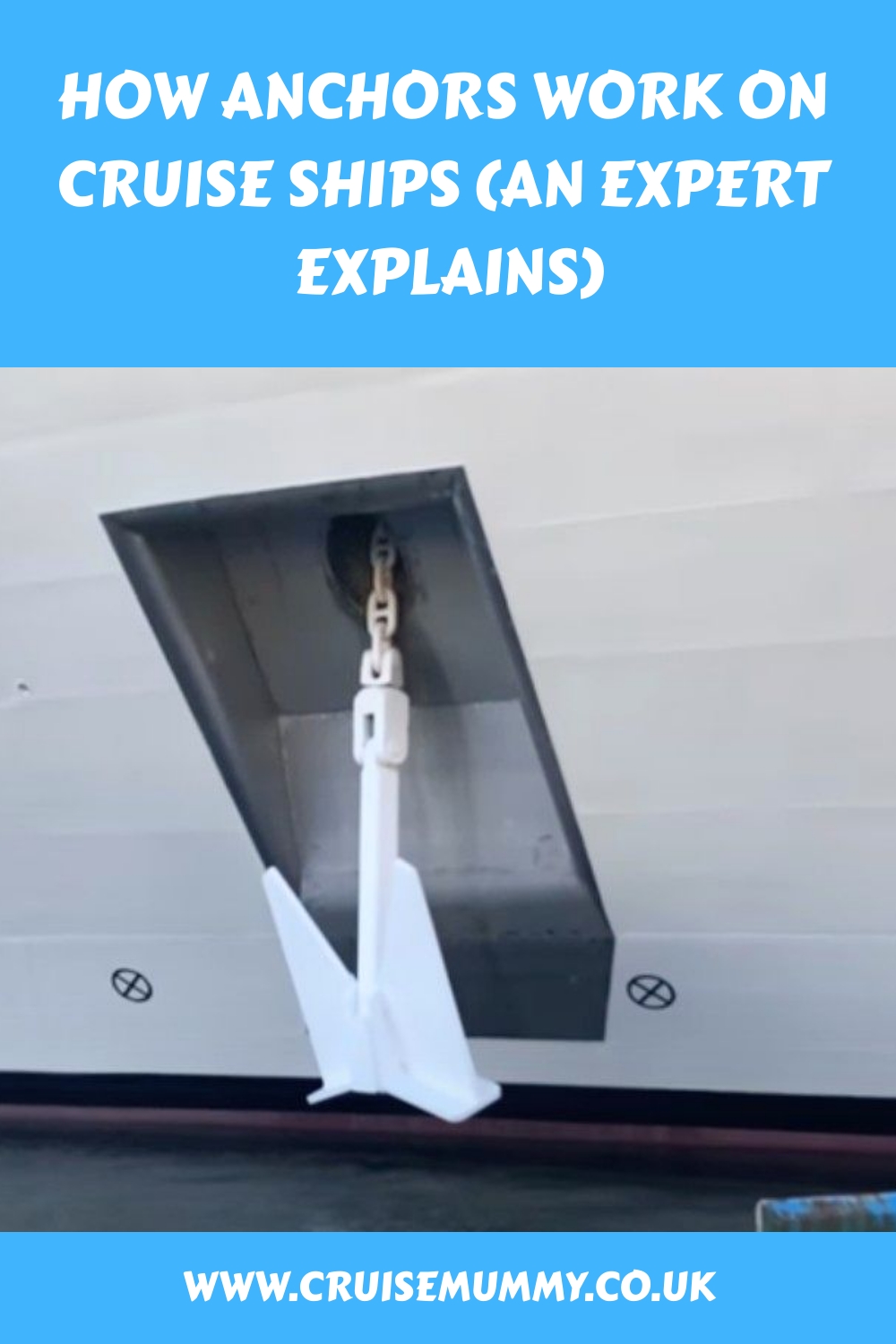Have you ever wondered how a massive cruise ship stays anchored in one spot? Me too.
Well, with the help of my cruise ship pilot friend, John, who has generously given up some of his time to help me with the technical stuff, we’ll break it down into simple terms for you.
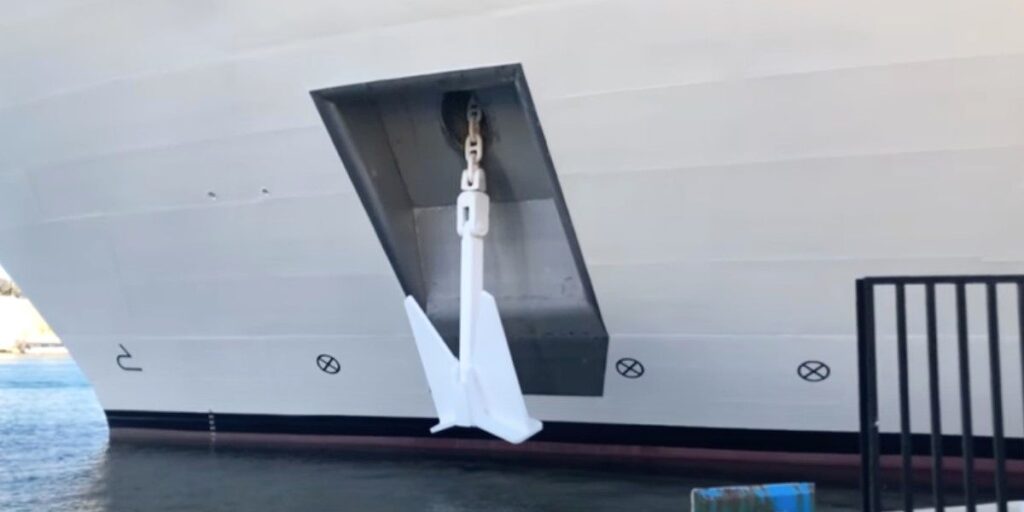
How Many Anchors Does A Cruise Ship Have?
Most cruise ships have two anchors, one on each side of the ship.
There’s an old saying that the starboard anchor is used in the southern hemisphere and the port anchor in the northern hemisphere. This is due to the Coriolis force, which causes storm systems to rotate clockwise in the north and anticlockwise in the south. Using the appropriate anchor can prevent cables from getting tangled when a second anchor is dropped.
But in reality, the anchors are alternated so that they wear equally.
Sometimes, if you’re cruising into a place and you’re going to be turning into a current slightly, it’s more prudent to put down the anchor which is on the current side of the vessel.
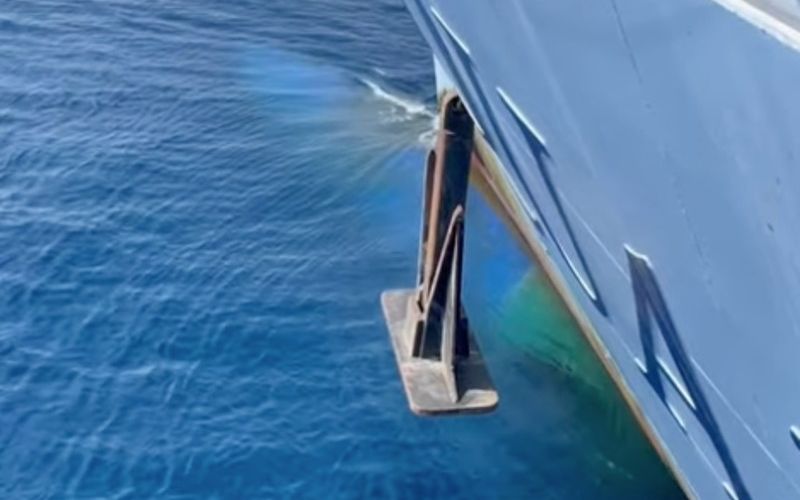
How Big Is The Anchor On A Cruise Ship?
The weight of the anchor is determined by the size of the ship. On a large cruise ship, the anchor may weigh in the region of 8 tons. That’s about the same weight as an African elephant or a standard school bus.
Here’s a photo of the anchor of an average-sized cruise ship, the Norwegian Jewel, next to a person…
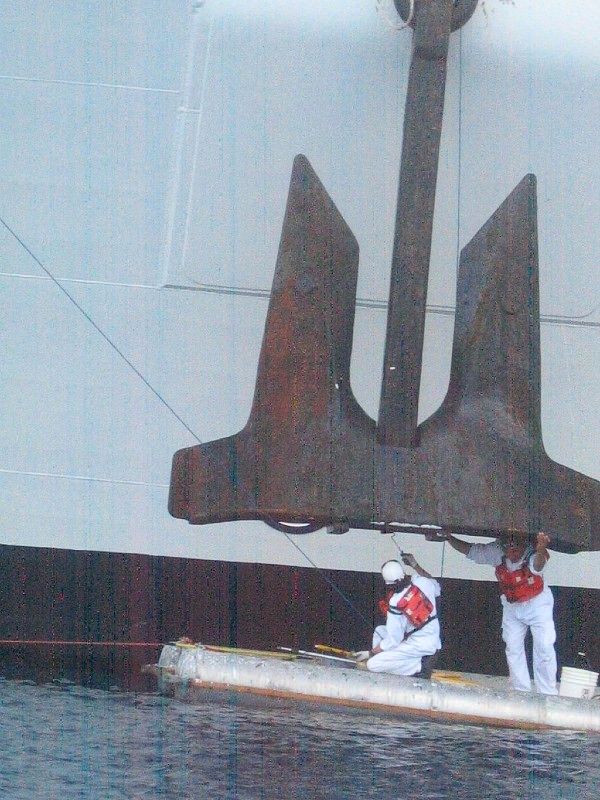
And below, you can see me with the anchor of the S.S. Great Britain – the world’s first ocean liner which sailed from 1845 until 1886.

As you can see, the size is similar, although the shape of cruise ship anchors has changed quite a lot over the past 170 years.
How Long Is The Anchor Chain On A Cruise Ship?
Anchor chains are measured in lengths called shackles. One shackle of the chain is 15 fathoms long, this equates to 90 feet or approximately 27 metres.
Most cruise ships have chains that are either ten or eleven shackles long, but it could be up to 13 shackles long. So the anchor chains are around 900-990 feet or 270-297 metres long.
For comparison, Wonder of the Seas is 1,188 feet or 362 metres long. So the anchor chain is roughly as long as the ship, but it may be a bit longer or a bit shorter.

How big and heavy is each piece of the chain?
For a large cruise ship, each link in an anchor chain weighs around 50 kg – that’s roughly the same weight as a 12-year-old child.
There are around 1,000 links in the chain, so the whole anchor chain will weigh around 50 tons. Of course, with smaller ships, the anchor and the chain will weigh less than this.
Not all of the chain is let out. When it comes to dropping the anchor, the general rule of thumb is to lay out four to five times the length of the water’s depth in chain.
So, if the water is 25 meters deep, you’ll need approximately 100 to 125 meters of chain. The length of the chain can vary due to wind and currents, and sometimes it’s necessary to let out more chain or shorten it.
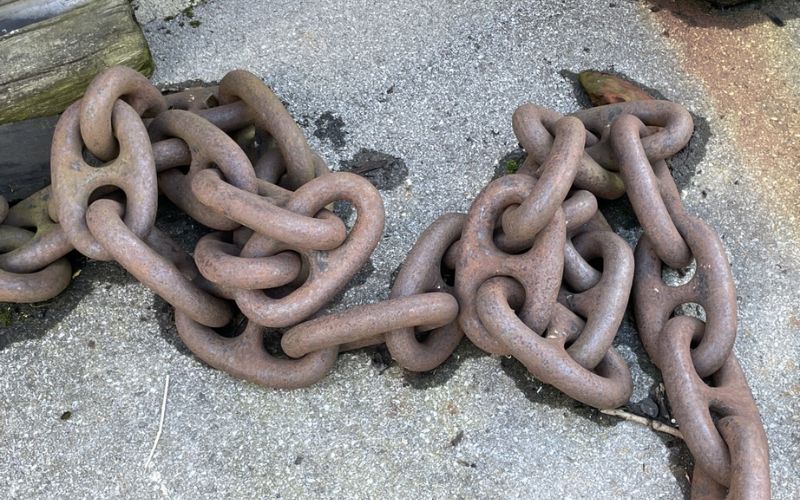
Where Are Cruise Ship Anchor Chains Stored?
Anchor chains are contained in a chain locker on both the port and starboard sides. This is located underneath the windlass (the winch that recovers the anchor from the ocean floor), towards the front of the ship.
The end of the chain is secured to the ship, which is called the bitter end. In emergencies, the chain can be released by knocking out a pin in the bitter end. In dry docks, the entire chain can be removed and then reversed and put back in. This equalises the wear on it.
The pipe that the anchor cable chain goes down from the windlass to the outside of the ship is called the hawsepipe. The anchors are hauled up into this hawsepipe and secured in place. When a ship anchors, it does so at zero speed over the ground or with a very small amount of stern way.
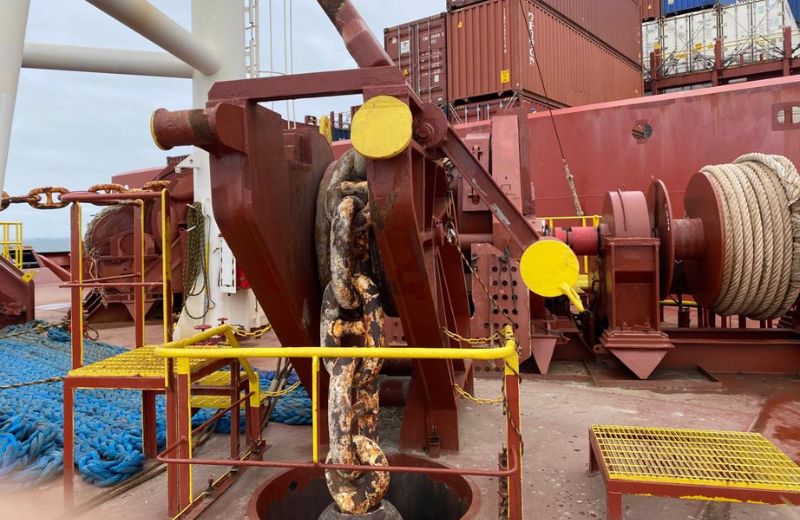
What Happens When The Anchor Is Dropped?
When a ship is brought to anchor, the speed is reduced to the minimum necessary for steering. The engines are then put into reverse to generate sternway, and the anchor is dropped onto the bottom.
The machine that’s used to drop and recover the anchor is called a windless. This handy contraption is usually electrically powered on cruise ships, but usually hydraulically powered on tankers and cargo ships.

Letting go of the anchor is known as ‘walking the anchor out’. The anchor will be brought to just above the water where it hangs free. The nautical term for this is a ‘cockabill and anchor’.
When it’s time to drop the anchor, an officer on the bridge will give the command to release it, and the brake on the windlass is released.
The anchor cannot be dropped all at once or it will pile up. The speed at which the anchor drops is controlled by a brake.
This can be a pretty noisy and messy process, with dust and rust flying around. The anchor will hit the bottom of the ocean, and then the ship will start to lay it out.
Watching a ship come to anchor early in the morning can be quite the spectacle. If you’re lucky enough to see it, you may notice the wash from the propellers come alongside the vessel as it comes astern. Once the wash reaches the middle of the ship, it’s a sign that the ship has stopped moving through the water.
This interesting video shows how an anchor is dropped on Island Princess…
How Does An Anchor Hold A Cruise Ship In Place?
A ship is not held by an anchor when it anchors. So when you’re on a cruise and it anchors to tender, the anchor will go down on the bottom and the hooks in the end, which are called the flukes will lay towards the bottom and will usually bury themselves. Then the chain is laid out across the seabed.
When you’re in the tender boat, you’ll see that the chain is almost vertical. That’s called the catenary of the chain.
The catenary of the chain is what holds the ship in place and the ship will swing around this but not drift very far.
Anchors Don’t Always Work
Some places are better for anchoring than others. On a chart on a ship, it indicates the nature of the bottom – whether it’s what’s known as ‘good holding ground’ or ‘poor holding ground’.
Good holding ground would suggest that the anchor will sit on the bottom there and will hold successfully. On poor holding ground the anchor would not sit successfully on the seabed and would drag.
Mud or softer ground is very good holding ground, but harder ground generally isn’t. If an anchor drags, in other words, the ship is moving away from the anchor and the cables come tight, the anchor breaks away from the bottom. Dragging can be caused by a number of things like wind or current.
There are a number of remedies for this. The first method would be to lengthen the cable so you have a longer catenary. If this is unsuccessful, then the crew may have to pick the anchor up again and re-anchor in a different position.
If this is unsuccessful again the vessel keeps tracking anchor, the only remedy is to pick up the anchor and go and steam off somewhere safe and just drift.
Anchors Can Be Used For Maneuvering
Anchors can be used as a manoeuvring aid. While cruise ships typically have various tools such as bow thrusters, propellers and Azipods or rudders, there are occasions where an anchor can be useful.
The process involves lowering the anchor until it just touches the bottom, causing the ship to turn on that position. This transfers the steering point of the vessel to where the anchor comes out of the ship and the ship will turn on that position.
How Is A Cruise Ship Anchor Raised?
To recover the anchor, the process of dropping it is reversed. The officer on the bridge lets the captain know which way the cable is laying and how much weight is in it. Then, the ship will turn towards the cable to take the weight off it, and the anchor will be heaved back up onto the ship.
You can tell when the anchor comes off the bottom because starts to sway very gently. This will be relayed to the bridge as ‘anchor away’.
The anchor is hauled up and when it breaks the water the term ‘anchor sighted’ will be relayed to the bridge. Then, it’s hauled all the way back up into the hawsepipe and the message is ‘anchor home’.
When the anchor is sighted, the ship can commence moving safely forward.
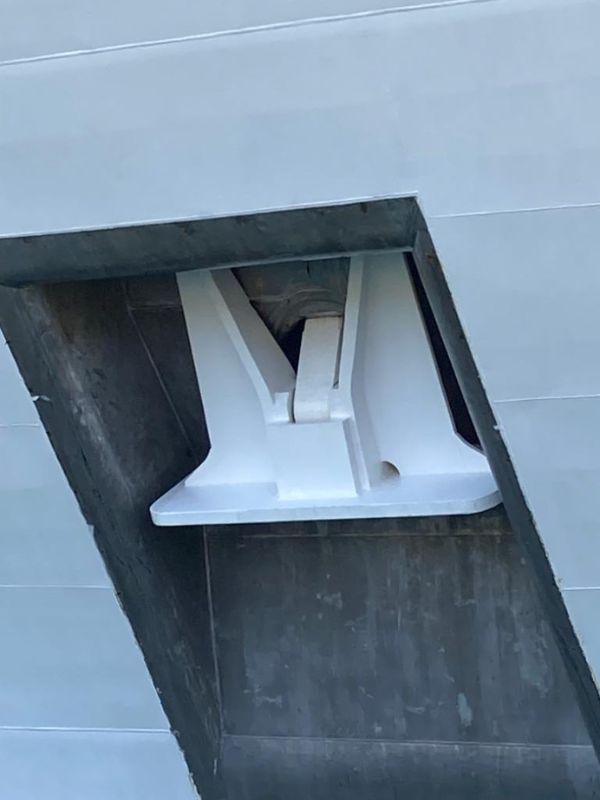
The bottom line
I hope that this article has answered your questions about cruise ship anchors. I find all this info fascinating and am very grateful to John for helping me learn all the details.
If you have any question, please make use of the comments section below to ask. Otherwise, why not check out some of our other technical cruise ship articles:
- Cruise Ship Propellers
- Cruise Ship Rudders
- What Is The Bottom Of A Ship Called?
- How Fast Do Cruise Ships Go?
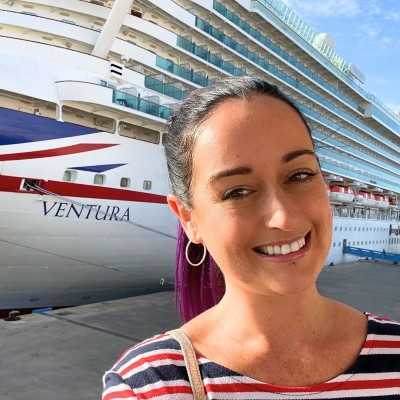
Jenni Fielding is the founder of Cruise Mummy. She has worked in the cruise industry since 2015 and has taken over 30 cruises. Now, she helps over 1 million people per month to plan their perfect cruise holidays.

